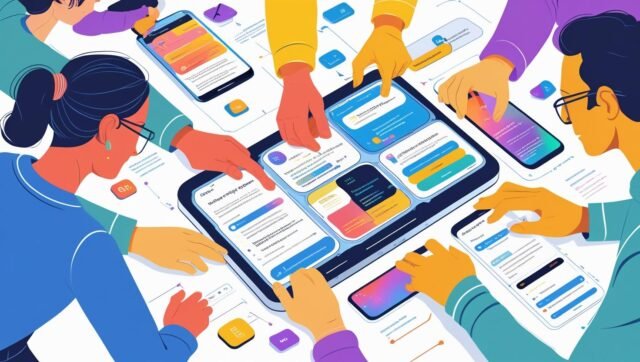In a world where smartphones have become an extension of human life, ensuring mobile app accessibility is not just a good practice—it’s a necessity. In 2025, digital inclusivity is no longer optional. Great developers recognize that building accessible mobile apps opens the door to wider audiences, increased user retention, and social responsibility.
As technology evolves, so do the expectations of users with disabilities. Whether it’s visual, auditory, cognitive, or motor impairments, people deserve equal access to digital content. For forward-thinking businesses—especially those offering travel app development services accessibility is a powerful competitive edge.
In this blog, we’ll explore the key accessibility standards top developers follow in 2025 and why they matter more than ever.
Why Accessibility Matters More Than Ever in 2025
Globally, over 1.3 billion people experience some form of disability. Yet, many mobile apps remain difficult—or even impossible—for them to use. With the rise of voice-first technology, AI, and AR, the digital divide is widening for those not considered in the design process.
In 2025, consumers are more socially conscious, and accessibility is increasingly tied to brand trust, legal compliance, and global market reach. Countries like the U.S. (under the ADA), Canada (under the ACA), and the EU (with EN 301 549) are enforcing accessibility guidelines more strictly.
Ignoring this now risks lawsuits, lost users, and reputational damage.
Key Accessibility Standards Great Developers Follow
1. WCAG 2.2 Compliance
The Web Content Accessibility Guidelines (WCAG) 2.2 are the gold standard. While originally designed for web, they apply to mobile apps too. These guidelines include:
- Perceivable: Content must be available to all senses.
- Operable: Users must be able to navigate with assistive tools.
- Understandable: Interfaces must be predictable and easy to use.
- Robust: Content must work across all platforms and devices.
Great developers build apps to meet at least WCAG Level AA, ensuring a balance between usability and cost-efficiency.
2. VoiceOver, TalkBack, and Screen Reader Support
In 2025, screen reader technology has become more intelligent. But for it to work, app developers must:
- Provide alt text for images
- Ensure all buttons are labeled
- Avoid using images as text
- Use proper semantic structures in code
This is especially vital for travel app development services, where visual-heavy interfaces (like maps, photos, icons) are common. Making these accessible boosts usability for visually impaired travelers.
3. Color Contrast & Visual Hierarchy
Color blindness affects approximately 8% of men and 0.5% of women worldwide. Developers now use automated tools to ensure:
- Sufficient contrast between text and background
- No reliance on color alone to convey information
- Clear font sizes and spacing for readability
In travel apps, where urgency and clarity are critical (e.g., booking confirmations, flight times), poor contrast can lead to user frustration or even missed flights.
4. Dynamic Text & Responsive Layouts
Users should be able to scale text sizes without breaking the layout. This helps people with low vision or dyslexia read content easily.
In 2025, top mobile app development companies use responsive frameworks that adapt seamlessly to font scaling. For example, travel booking screens must remain fully functional even when text size is increased by 200%.
5. Keyboard Navigation and Gesture Alternatives
Not all users can use touchscreen gestures. Some rely on external keyboards or switch controls. Therefore, developers must:
- Support tab-based navigation
- Provide focus indicators
- Avoid gesture-only commands
For travel apps, this means users should be able to complete critical actions—like booking a hotel or checking in—without relying solely on swipes or taps.
6. Closed Captions and Audio Descriptions
With more apps offering video content from travel vlogs to destination guides—access to sound isn’t guaranteed for all users. Great developers:
- Add closed captions to videos
- Offer transcripts or audio descriptions
- Ensure volume control is accessible within the app
This enhances inclusivity while boosting SEO and content discoverability.
Travel App Development Services and Accessibility
The travel industry has seen a massive digital transformation. With more people using mobile devices to book, navigate, and share their travel experiences, accessibility in travel apps is crucial.
Companies offering travel app development services must consider:
- Location-based features that work with voice assistants
- Emergency support access for travelers with disabilities
- Real-time text alerts for flight changes or delays
- Accessible filters and sorting for hotel and flight results
The goal is to make the entire travel journey—planning, booking, and navigating—as seamless as possible for all users.
Example:
Imagine a travel app that helps a visually impaired user book a hotel in Tokyo using voice commands, haptic feedback, and screen reader guidance. That’s not just smart design—it’s life-changing accessibility.
The Role of AI in Accessibility (2025)
Artificial Intelligence is now deeply embedded in mobile development. Here’s how AI supports accessibility:
- Image Recognition: Auto-generates alt text for user-uploaded images
- Real-Time Translation: Helps users understand content in multiple languages
- Voice-to-Text Input: Enables hands-free form submissions and commands
- Personalized UX: Adapts app behavior based on user preferences and needs
AI isn’t replacing accessibility standards—it’s enhancing them.
Tools and Frameworks Developers Use in 2025
Top mobile app developers use modern tools to audit and improve accessibility:
- Google Accessibility Scanner (Android)
- Apple Accessibility Inspector (iOS)
- axe DevTools Mobile
- Figma Plugins for Contrast Checking
- Lighthouse for Mobile
For those offering travel app development services, using these tools ensures compliance and smooth user experiences across global devices.
Checklist: What to Look for in an Accessibility-Focused Development Company
If you’re hiring a mobile app development team in 2025, make sure they:
- Know WCAG 2.2 inside and out
- Prioritize inclusive UX design from day one
- Test with real users with disabilities
- Provide multi-modal input support
- Offer ongoing accessibility audits and updates
Accessibility isn’t a one-time fix—it’s an evolving practice. The best developers treat it as a core principle, not an afterthought.
Final Thoughts: Accessibility Is the Future of App Success
In 2025, inclusive design isn’t just about meeting legal standards—it’s about unlocking the full potential of your app for every user. Whether you’re building a social platform or offering travel app development services, accessibility leads to better UX, broader market reach, and genuine brand credibility.
The developers who win in 2025 and beyond will be the ones who design with empathy, innovation, and inclusion at their core.







